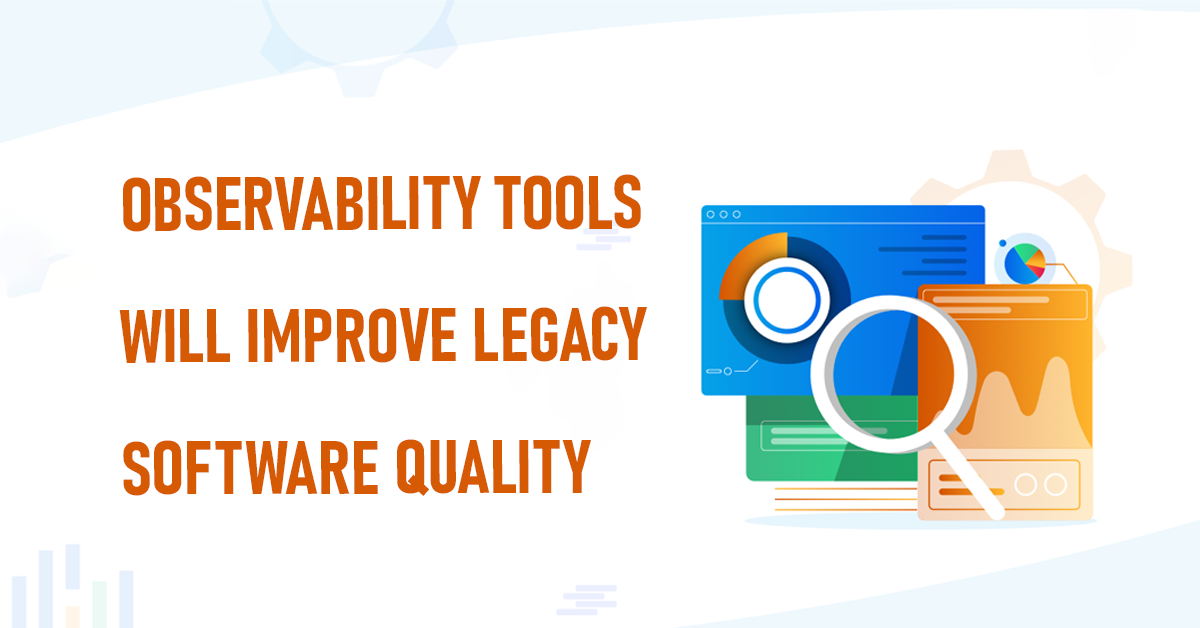Observability Tools Will Improve Legacy Software Quality

Data Scientist
Deep learning and machine learning specialist, well-versed with experience in Cloud infrastructure, Block-chain technologies, and Big Data solutions.
August 01, 2022

Observability tools provide real-time insight into application behavior and performance. They enable developers, testers, and operations teams to identify issues before they cause problems or harm.
In addition to monitoring individual events, Observability solutions also offer comprehensive views of runtime state, allowing applications to see their entire history. This helps detect both latent errors that only become apparent after months of operation and known regressions, such as security vulnerabilities or feature bugs. The complexity of modern software systems means there is no single solution that fits every situation. Instead, each organization should choose from a range of options tailored to its requirements.
Let us know more about Observability
Observability refers to the ability of developers or system administrators to track every change that occurs within software function. This allows them to see exactly where they stand at each point in time, and fix issues before they impact.
With observability tools, you can gain insight into your system without having to wait for performance reports from users or running costly infrastructure monitoring solutions. Most modern applications offer some level of observability today, whether through a dashboard or logging tool built directly into the codebase.
As the complexity of systems continues to increase, observability requirements become critical to maintaining high availability. In this session, we will look at what makes a system observable, and how observability tools can help with legacy software. We will discuss what to look for in an observability tool, what considerations should be taken into account when choosing one, and how to go about building out an observability solution.
There are five major categories of observable events in a software system. Each category provides distinct information, enabling a wide variety of insights into how your software performs.
1. Code Reviews
Code reviews are great tools that software developers use to ensure consistency within their code. They are especially useful in legacy software where quality control is difficult due to a lack of resources. By reviewing older code written by others, they can learn what works well and what doesn't. This way, they can write code using best practices and avoid repeating past mistakes. Reviewing old code is not only valuable for learning, but it's also helpful in finding bugs that have been missed over time.
2. Unit Testing
Unit testing is a powerful tool that helps prevent errors in legacy systems. When unit tests are integrated into a project, they provide programmers with information regarding how changes affect existing functionality. If a change causes unexpected consequences, then it becomes clear whether there was a bug in the original design or if a specific function changed unexpectedly. A combination of both types of unit testing (design-based testing and behavior-driven) increases the amount of coverage while reducing the number of false positives.
3. Manual Testing
Manual testing is the act of manually running programs and observing their results. While it does require human interaction, manual testing provides a much higher level of accuracy than automatic testing methods. In addition to being able to identify bugs early on, manual testers can verify how changes affect the program and validate its logic. As many developers know, it's possible to test and debug legacy projects using automated means alone, however, this approach often misses fundamental flaws in the system.
4. Issue Tracking Systems
Issue tracking systems help teams track problems and resolve them efficiently. These tools allow team members to communicate effectively and collaborate around issues, streamlining processes across the entire organization. Unfortunately, issue tracking is often neglected in legacy applications because they are focused on delivering features rather than fixing problems. However, without an effective issue management system, progress is slowed significantly. Legacy issues may need to be resolved before new ones can be created since each problem requires additional documentation and research. An issue tracker ensures these steps are completed correctly.
5. Risk Assessment Workshops
Risk assessment workshops are a method of identifying weaknesses in a system to reduce the risk of failure. Once identified, these weaknesses can be addressed through modifications or improvements to the system. One of the biggest challenges with legacy systems is that different people designed them at different times who did not necessarily consider security. Therefore, it's likely that vulnerabilities present themselves as soon as the application is released. Instead of waiting until those vulnerabilities cause harm, risk assessments are performed before release and any risks deemed unacceptable are mitigated accordingly.
Tools for collecting, presenting, and acting upon data tend to fall into two categories. On one hand, we have automation solutions, which provide pre-built features for managing collections of data points over time. On the other hand, we have reactive tools, which react to specific conditions and send alerts when they occur. Automation tools are often built around a central repository of historical data. Reactive tools tend to focus on detecting particular patterns instead of relying on history.
Both types of tools can be combined to build highly effective observability solutions. A good example would be a dashboard that shows data from a centralized location while alerting users whenever certain conditions change. When dealing with complex software, it's always best to start with what you already use. Your existing infrastructure and tools should be a starting point for planning. Then, once you have a plan, choose the right tools to implement it.
Here are some of the characteristics of these tools
1. Data collection and visualization
There are many different ways to introduce observability into existing systems. Different kinds of data can be collected directly from processes or can be inferred indirectly from interactions between parts of the system. In general, however, the same principles apply no matter how the data is obtained.
Data collection is the first step toward making something visible. It's a prerequisite for the rest of the observability journey. Many tools exist to help collect data, including standard ones such as loggers and monitors, as well as specialized services provided by cloud-based applications.
Once data has been collected, visualizing it is critical to getting full insight into what is going on. It can show trends in data over time, expose anomalies, identify problems early, or even predict future events. Visualization tools range from simple dashboards to sophisticated data analysis applications.
2. High availability
Observability tools can view what is happening at any time and do something about it if it is not right. High Availability means that your application is accessible and functional regardless of whether you're running it yourself, or someone else is using it at any time and anywhere.
3. Easy installation
A big advantage of these tools is their ease of deployment since the only thing you need to do is to add some Java/C++ code to the production environment. Of course, you want to make sure that you don't rely solely on the built-in monitoring capabilities of the application, but also use observability tools to complement those capabilities.
4. Reliable and accurate
There are many different types of observations available and each tool offers its way of performing these tasks. When it comes to observability, we need to focus on reliability and accuracy. Observability tools do not introduce any errors when they are running. the results are accurate and reliable. Observability tools can provide us with the correct information about our code, but only if we have the right data.
5. Real-time monitoring
Real-time monitoring provides insights to assist decision-making without the need to analyze historical data. This eliminates the risk of misinterpretation based on past performance. In addition, real-time information can provide insights into trends and patterns that may not otherwise be known. This helps us optimally make decisions.
6. Continuous improvement
Most observability tools have features that let you run tests automatically over time. These tests check for conditions that weren’t previously detected. When you detect changes, you can fix them right away, so your applications work more reliably. Observability tools always improve themselves based on feedback and data collected over time.
We recommend tools based on the following criteria:
- Fast startup
- Quick analysis
- Easy setup
- Simple user interface
- Supports many languages (C, Java, Python, JavaScript,...)
Conclusion
Observability tools provide real-time insight into legacy software behavior and performance. Legacy software’s hard to maintain, and these tools give visibility into what's happening behind the scenes. Legacy apps often do not get enough attention, and observability tools will provide feedback on what is working and what is not.













